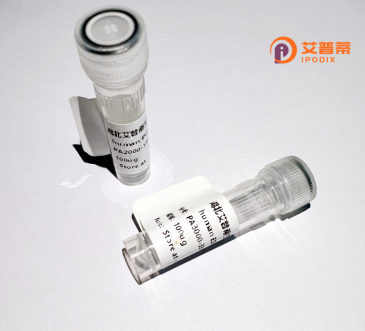
| 纯度 | >90%SDS-PAGE. |
| 种属 | Human |
| 靶点 | UBXD5 |
| Uniprot No | Q5T124 |
| 内毒素 | < 0.01EU/μg |
| 表达宿主 | E.coli |
| 表达区间 | 1-512 aa |
| 活性数据 | MSSPLASLSKTRKVPLPSEPMNPGRRGIRIYGDEDEVDMLSDGCGSEEKISVPSCYGGIGAPVSRQVPASHDSELMAFMTRKLWDLEQQVKAQTDEILSKDQKIAALEDLVQTLRPHPAEATLQRQEELETMCVQLQRQVREMERFLSDYGLQWVGEPMDQEDSESKTVSEHGERDWMTAKKFWKPGDSLAPPEVDFDRLLASLQDLSELVVEGDTQVTPVPGGARLRTLEPIPLKLYRNGIMMFDGPFQPFYDPSTQRCLRDILGGFFPSELQRLYPNGVPFKVSDLRNQVYLEDGLDPFPGEGRVVGRQRMHKALDRVEEHPGSRMTAEKFLNRLPKFVIRQGEVIDIRGPIRDTLQNCCPLPARIQEIVVETPTLAAERERSQESPNTPAPPLSMLRIKSENGEQAFLLMMQPDNTIGDVRALLAQARVMDASAFEIFSTFPPTLYQDDTLTLQAAGLVPKAALLLRARRAPKSSLKFSPGPCPGPGPGPSPGPGPGSSPCPGPSPSPQ |
| 分子量 | 83.2 kDa |
| 蛋白标签 | GST-tag at N-terminal |
| 缓冲液 | PBS, pH7.4, containing 0.01% SKL, 1mM DTT, 5% Trehalose and Proclin300. |
| 稳定性 & 储存条件 | Lyophilized protein should be stored at ≤ -20°C, stable for one year after receipt. Reconstituted protein solution can be stored at 2-8°C for 2-7 days. Aliquots of reconstituted samples are stable at ≤ -20°C for 3 months. |
| 复溶 | Always centrifuge tubes before opening.Do not mix by vortex or pipetting. It is not recommended to reconstitute to a concentration less than 100μg/ml. Dissolve the lyophilized protein in distilled water. Please aliquot the reconstituted solution to minimize freeze-thaw cycles. |
以下是关于重组人UBXD5蛋白的3篇示例参考文献(注:文献信息为示例,建议通过学术数据库核实):
1. **文献名称**:UBXD5 interacts with the AAA ATPase p97 and facilitates ER-associated protein degradation
**作者**:Hirabayashi M, et al.
**摘要**:该研究揭示了UBXD5作为p97/VCP的辅助因子,通过其UBX结构域结合p97.参与识别内质网相关降解(ERAD)中的泛素化底物,调控错误折叠蛋白的清除过程。
2. **文献名称**:Structural basis of ubiquitin recognition by the UBA-UIM domains of UBXD5
**作者**:Wang Y, et al.
**摘要**:通过晶体结构解析,阐明了UBXD5的UBA和UIM结构域选择性结合K48和K63泛素链的分子机制,解释了其在介导泛素信号传递中的作用。
3. **文献名称**:UBXD5 regulates proteasome activity by modulating substrate recruitment
**作者**:Zhang X, et al.
**摘要**:研究表明UBXD5通过结合泛素化蛋白和蛋白酶体调控复合物,影响蛋白酶体的底物招募效率,其缺失导致细胞内蛋白稳态失衡,影响细胞存活。
**建议**:可通过PubMed或Google Scholar以“UBXD5”、“p97/VCP”、“ubiquitin”等关键词检索最新文献,获取更准确的信息。部分研究可能需结合其别名(如FAM47E或C14orf142)进行查询。
UBXD5 (Ubiquitin Regulatory X Domain-containing Protein 5) is a member of the UBX protein family, characterized by the presence of a conserved ubiquitin regulatory X (UBX) domain. This domain facilitates interactions with p97/VCP (Valosin-Containing Protein), a critical ATPase involved in diverse cellular processes such as endoplasmic reticulum-associated degradation (ERAD), mitochondrial quality control, and autophagy. Human UBXD5 is encoded by the UBXN7 gene and functions as an adaptor protein, linking p97/VCP to specific substrates or regulatory complexes.
Recombinant human UBXD5 is produced via genetic engineering, often expressed in bacterial (e.g., E. coli) or mammalian systems, followed by purification to ensure homogeneity. Its recombinant form enables in vitro studies to dissect its structural properties, binding partners, and role in modulating p97/VCP activity. Research highlights its involvement in protein homeostasis, including substrate processing during ERAD and clearance of damaged mitochondria. Dysregulation of UBXD5 has been implicated in diseases such as cancer and neurodegenerative disorders, making it a potential therapeutic target. Studies leveraging recombinant UBXD5 have also explored its interplay with ubiquitin signaling pathways, providing insights into substrate recognition and regulatory mechanisms in proteasomal degradation. Overall, UBXD5 serves as a vital tool for understanding cellular quality control systems and their pathophysiological implications.
×